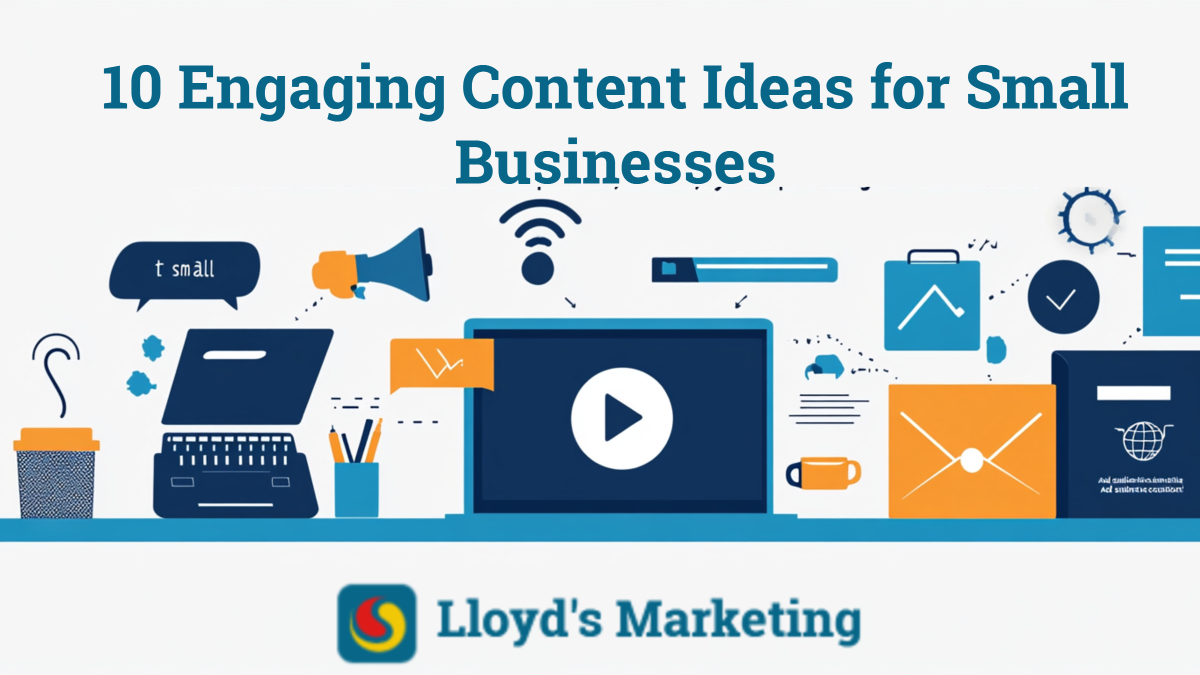Table of Contents
Introduction
In today’s digital landscape, small businesses face unique challenges and opportunities when establishing a robust online presence. Whether you’re a local bakery, a boutique clothing shop, or a digital marketing agency, crafting engaging content is essential for attracting and retaining customers. This article explores ten innovative content ideas for small businesses to enhance visibility, connect with their audience, and drive sales.
1. Share Your Story
Humanise Your Brand with Your Business Journey
Every small business has a unique story behind its inception. Sharing this narrative humanises your brand, creating an emotional connection with your audience. Talk about your motivations for starting the business, the passion driving you, and the values guiding your operations. By being transparent about your journey, you build trust, encouraging customers to support you knowing they are contributing to a cause they resonate with.
Consider writing a blog post or creating a video that outlines your founding story, highlighting key milestones such as your first sale or notable challenges you’ve overcome. You foster loyalty and community support by inviting your audience to share in your journey.
Discuss Challenges Faced and Overcome
Don’t just share the good times; discussing the challenges you’ve encountered can be equally powerful. Whether financial, operational, or personal, these struggles make your story relatable and showcase your resilience—traits customers often admire. Use social media to post snippets about overcoming specific obstacles, employing hashtags relevant to entrepreneurship to reach a broader audience.
Talk About Your Future Goals
Looking to the future, share your aspirations and business goals. This could involve expanding your product range, opening a new location, or entering a new market. Giving your audience insight into where you’re heading creates anticipation and encourages them to follow your journey. You could even invite feedback or suggestions to make them feel more involved in your growth.
2. Customer Testimonials and Case Studies
Highlight Real Success Stories
Nothing validates the quality of your product or service more than a customer testimonial. Collecting and showcasing real success stories can significantly influence potential customers’ decisions. Use a variety of formats—written testimonials, audio clips, and video interviews—to present these stories compellingly.
Create a dedicated section on your website for customer testimonials, categorising them by product or service type to help visitors find relevant experiences that resonate with their needs. Real-life stories build credibility and are powerful marketing tools for small businesses.
Use Video Testimonials for Extra Impact
Video testimonials convey authenticity and emotion in a way that text cannot. A short, well-produced video featuring a satisfied customer can instil trust and encourage prospective customers to purchase. Feature these videos on your homepage or social media channels, making them easily shareable to maximise their reach.
3. Behind-the-Scenes Content Give a Peek Behind the Curtain
Sharing your business’s “day in the life” can be engaging and informative. Consider a blog post or video that showcases your daily operations, from morning routines to product preparation. Such content allows customers to appreciate the effort behind the scenes, making them feel more connected to your brand.
Introduce Your Team
Showcasing the people who make your business thrive adds a personal touch. Share employee profiles or short videos highlighting team members’ roles and skills and some fun personal facts. Creating a dedicated section for employee spotlights on your website or social media strengthens relationships with your customers by letting them see the faces behind the brand.
Detail Your Product Creation Process
Customers often appreciate knowing how products are made or services delivered. Share the process behind your offerings to enhance their appreciation for your business. Create detailed blog posts or videos showing the journey from concept to completion. This level of transparency builds trust and differentiates your brand from competitors.
Educational Blog Posts
Create How-To Guides Relevant to Your Industry
Informative how-to guides provide value to your audience and establish your business as an authority in your field. For example, a “How to Maintain Your Lawn” guide could be helpful and keyword-rich if you run a landscaping business. This content boosts your search engine rankings, driving organic traffic to your website.
Share Tips and Tricks for Customers
In addition to comprehensive guides, share quick tips in short blog posts, infographics, or social media updates. Topics like “5 Quick Fixes for Common Home Repairs” or “Top 10 Marketing Mistakes to Avoid” can position your business as a go-to resource, encouraging repeat visits to your website.
Provide Industry News and Insights
Keep your audience informed with regular blog posts or newsletters covering your industry’s latest developments. This will position your business as a thought leader and attract new customers searching for reliable industry information.
5. Interactive Quizzes and Polls
Engage with Fun Quizzes
Interactive content like quizzes can significantly boost engagement. Create quizzes relevant to your products, such as “What Type of Coffee Are You?” for a café. These quizzes entertain your audience while providing insights into their preferences, helping you tailor your offerings.
Conduct Polls on Relevant Topics
Polls are a great way to gather valuable feedback and encourage audience interaction. Use social media to conduct polls about product preferences or service features. Sharing the results fosters a sense of community and encourages further discussion.
6. Infographics and Visual Content
Use Visuals to Explain Complex Ideas
Infographics are a great way to present complex data or information in a visually appealing format. They are particularly effective for communicating statistics, comparisons, or processes in an engaging and shareable way.
Create Step-by-Step Visual Guides
Infographics can also illustrate processes, such as how to assemble a product or use a service. These guides help customers quickly understand how to get the most from your products.
Share Branded Social Media Graphics
Create shareable graphics with compelling quotes or industry tips. When shared on social media, these can extend your reach. Always include your brand logo to maintain brand recognition.
7. Host Webinars or Live Q&A Sessions
Choose Topics That Resonate with Your Audience
Webinars and live Q&A sessions provide an interactive platform to engage with your audience. Choose topics relevant to your industry, such as “Effective Meal Planning” for a health food store, and promote these events through newsletters and social media.
Invite Guest Speakers for Added Value
Incorporating guest speakers into your webinars can attract a wider audience. Consider inviting industry experts to share their insights, adding depth to your content and boosting credibility.
8. User-Generated Content Campaigns
Encourage Customers to Share Their Experiences
User-generated content (UGC) is highly authentic and powerful social proof. Encourage customers to share photos or stories about their experiences with your business using a unique hashtag for easy tracking—feature customer content on your website or social media to foster community.
Run Contests to Incentivise Participation
Contests are an excellent way to encourage UGC. Ask customers to share photos or reviews for a chance to win prizes. Once the contest ends, showcase the winning entries, celebrating your customers and reinforcing their connection to your brand.
9. Seasonal Promotions and Content
Create Holiday-Themed Content
Seasonal promotions allow you to engage with timely content. Create blog posts or social media campaigns around holidays or local events. For instance, share festive recipes or promote seasonal products.
Offer Limited-Time Discounts
Seasonal promotions can include limited-time discounts to create a sense of urgency. Use appealing graphics to highlight these offers and share customer testimonials about the promoted products for added impact.
10. Collaborate with Other Businesses
Co-create Content with Complementary Brands
Collaborating with other businesses can expand your reach. Look for partners that complement your offerings and co-create content, such as joint blog posts or videos. This can help you leverage each other’s audiences.
Cross-Promote on Social Media
Once you’ve created content, promote each other on social media. Share posts highlighting your collaboration, tag your partner and encourage your followers to check them out. This approach fosters a supportive network that enhances your business’s reputation.
Conclusion
Implementing these content ideas for small businesses can significantly boost your online presence. By sharing your story, leveraging customer testimonials, and embracing user-generated content, you can build a dynamic content strategy that resonates with your audience. Consistency, creativity, and authenticity are crucial to standing out in the crowded digital landscape and fostering lasting customer relationships.
Frequently Asked Questions about Content Ideas for Small Business
How often should I post content for my small business?
Aim for at least one quality post per week, but adjust according to your audience’s engagement levels and capacity to create valuable content.
What type of content should I focus on?
Use a mix of educational, promotional, and interactive content tailored to your audience’s interests and industry trends.
How can I measure the success of my content strategy?
Track metrics such as website traffic, social media engagement, and conversion rates using analytics tools. This data can guide future content decisions.
Is user-generated content important for my business?
Absolutely. UGC fosters community, boosts credibility, and offers authentic content that resonates with potential customers.
What platforms are best for promoting my content?
Focus on platforms that match your target audience, such as Facebook, Instagram, and LinkedIn for small businesses.
Further reading about content ideas for small business
Complimentary Blog Posts
Getting the Best Bang from Your Blog: Master Content Repurposing
Unwrap Success: Innovative Christmas Marketing Ideas for Social Media Triumph
5 New Content Ideas Guaranteed to Get Clicks!
7 Best Types of Small Business Content Marketing You Can Adopt Now
How to Sell More with Content Marketing
Links to External Resources
HubSpot’s Guide to Content Marketing:
HubSpot’s extensive guide on content marketing covers everything from planning to execution. It explains the importance of content marketing in 2024, the types of content marketing, and why businesses need to focus on providing valuable content to build trust and brand authority. This can be a foundational resource for readers who want a deep dive into content marketing strategies.
Semrush’s Small Business Content Marketing Ideas
Semrush offers practical content marketing strategies specifically tailored for small businesses. It includes affordable and practical approaches, such as using customer feedback for content ideas and leveraging collaborations with local businesses. This is useful for readers seeking cost-effective ways to implement content marketing.
Copyblogger’s Guide to Small Business Content Marketing
Copyblogger offers simple yet effective content marketing tips for small businesses, including highlighting customer projects and creating content that explains key differentiators. This source is helpful for companies trying to establish their unique value proposition through content.

